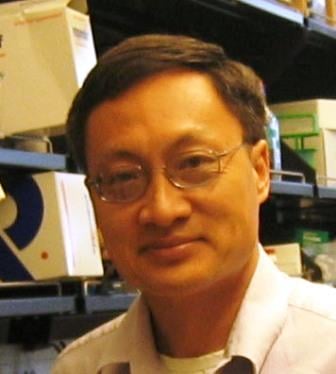 |
|
|
Fen-Biao Gao, PhD |
Researchers have determined how the most common gene mutation in amyotrophic lateral sclerosis (ALS) and frontotemporal dementia (FTD) disrupts normal cell function, providing insight likely to advance efforts to develop targeted therapies for these brain diseases. Scientists from UMass Medical School and St. Jude Children’s Research Hospital led the research, which appeared in the science journal Nature.
Investigators reported evidence that mutation of C9ORF72 interferes with the movement of RNAs and proteins into and out of the nucleus. Instructions for assembling new proteins are encoded in DNA in the cell nucleus. RNA carries this information out of the nucleus to the cytoplasm where proteins are made. The discovery reveals that the mutation to C9ORF72 blocks this transfer of information, setting the stage for the deterioration and death of neurons in the brain and spinal cord.
This year ALS will be diagnosed in about 5,600 U.S. residents. Ninety percent or more of patients report no family history of the disease. C9ORF72 mutations account for 4 to 6 percent of ALS in these patients and for 25 to 40 percent of ALS in those with family histories of the disease. FTD will be identified in a similar number of individuals.
The findings come four years after C9ORF72 was discovered and identified as the most common genetic cause of ALS, also known as Lou Gehrig disease. ALS is a progressive, neurodegenerative disorder affecting the motor neurons in the central nervous system. As motor neurons die, the brain’s ability to send signals to the body’s muscles is compromised. This leads to loss of voluntary muscle movement, paralysis and eventually respiratory failure. Mutations in the same gene also cause FTD, another neurodegenerative disorder that includes changes in behavior and personality, as well as problems with motor function. Until now, however, how the mutation disturbed cell function was unknown.
“Combining a simple fruit fly model with experiments in cells donated by ALS and FTD patients was essential for discovering the disease mechanism underlying mutations in C9ORF72,” said Fen-Biao Gao, PhD, professor of neurology at UMMS and co-corresponding author on the paper.
“C9ORF72 mutations are by far the most common genetic defect associated with both ALS and FTD, so understanding how the mutation causes disease is tremendously important for efforts to develop therapies to stop or reverse the death of neurons in the brain and spinal cord of patients,” said co-corresponding author J. Paul Taylor, MD, PhD, chair of cell and molecular biology at St. Jude and a Howard Hughes Medical Institute investigator. “Such therapies are desperately needed since there are no treatments proven to halt or reverse the disorders. Most patients die within five years of diagnosis.”
The research was funded in part by grants from the National Institutes of Health; Target ALS; The Packard Center for ALS Research at the Johns Hopkins University; the ALS Association, the ALS Therapy Alliance and ALSAC.